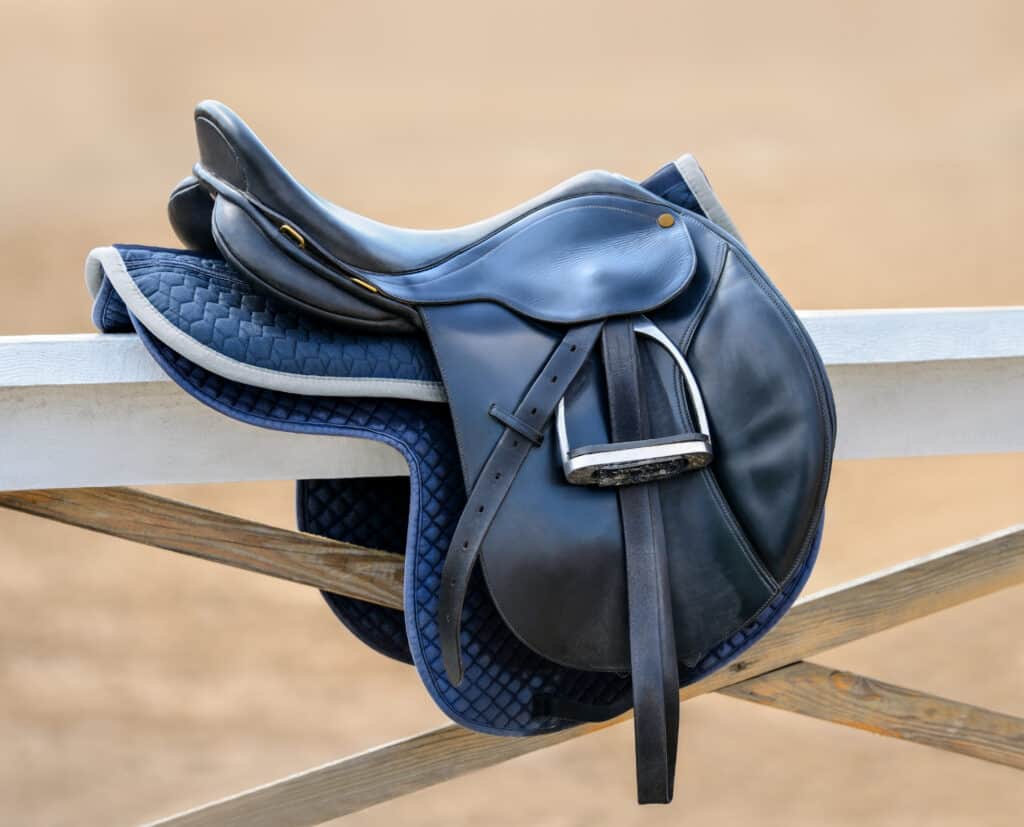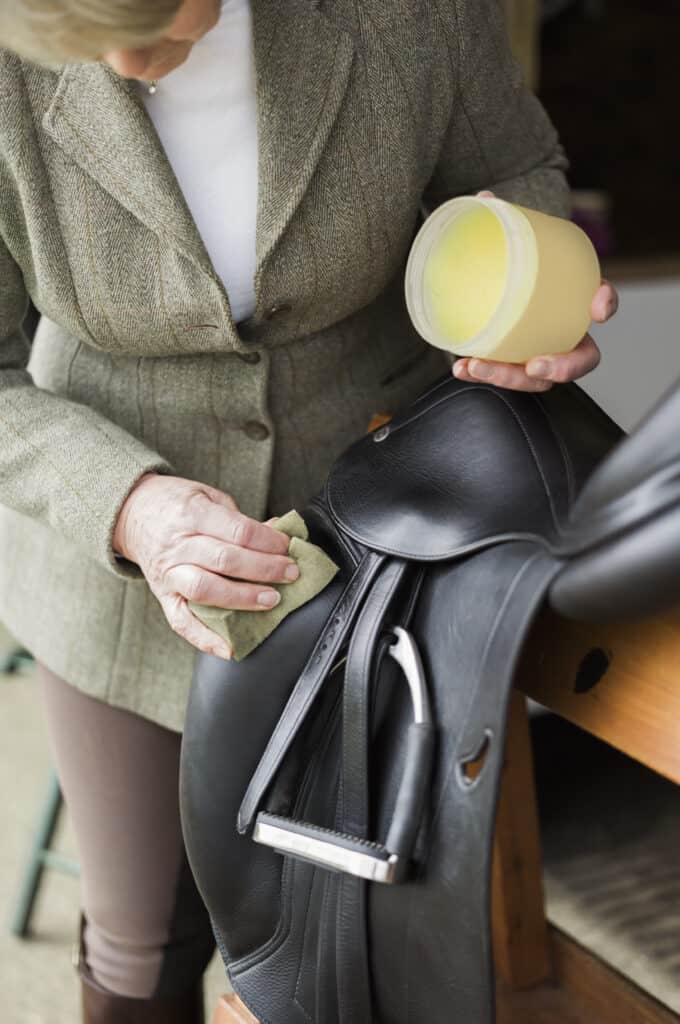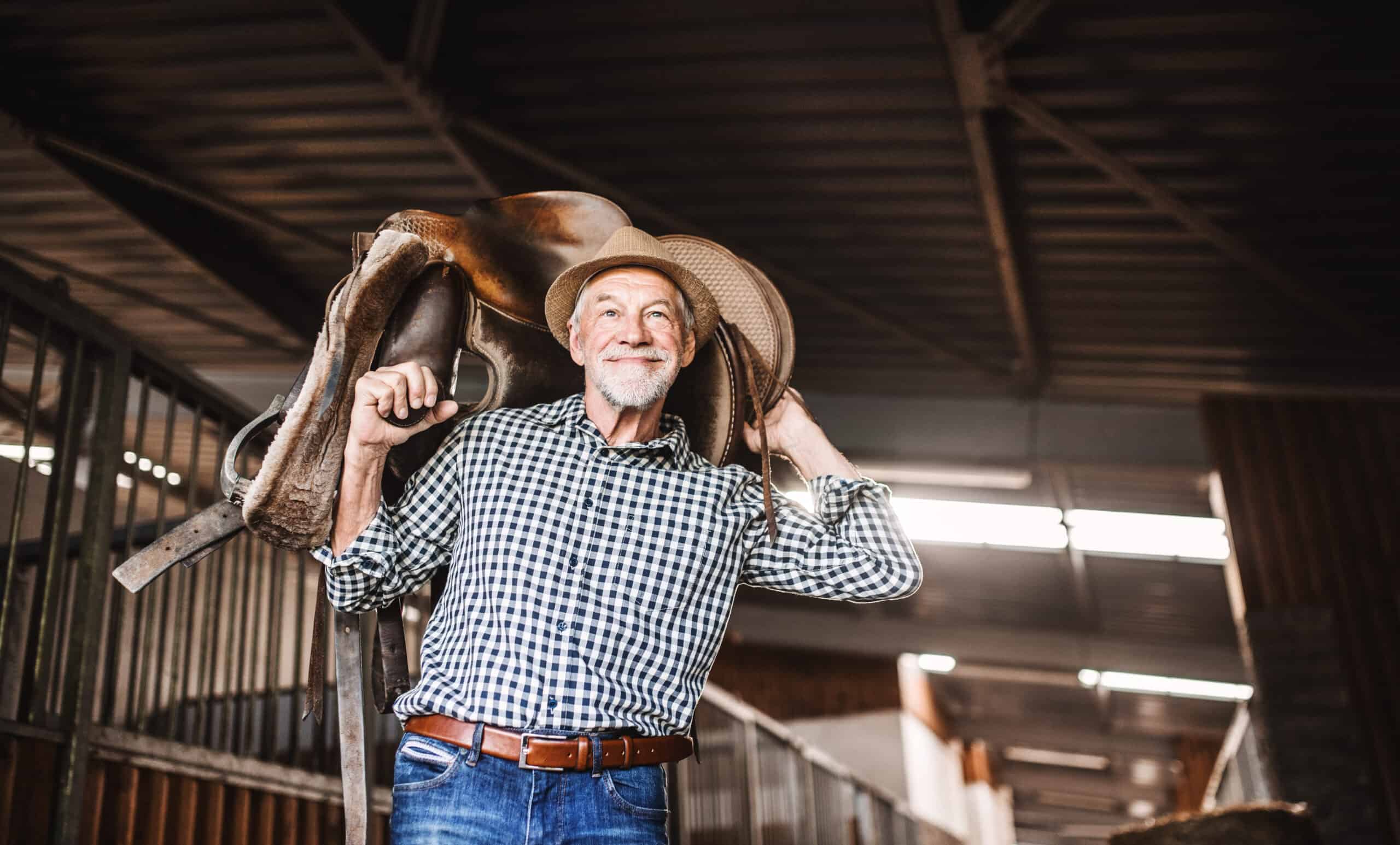Most people who are interested in horseback riding or just starting out will eventually reach the same question about tack: How much does a horse saddle cost?
Good-quality saddles can cost $500–$2,000 new or $100–$1,200 used.
Of course, it’s hard to nail down an exact price since so much will depend on how you intend to use the saddle and what kind of saddle quality you’re looking for. Let’s take a look at some factors that affect the price of horse saddles.
Factors To Consider When Deciding On A Horse Saddle
In general, most horseback riders have a decent saddle that’s comfortable for regular use and then additional saddles based on their interests.
After all, someone who just wants a cheap saddle to visit a family farm a few times a year isn’t going to have the same needs as a rider who competes in Olympic equestrian events.
Price ranges vary significantly, so it’s important to understand the types of standard saddles available, the materials they use, and when it’s time to look into an upgrade.
It may take some time to find the right saddle for both you and your horse.
For beginners who aren’t sure if they’re going to stick with horseback riding, cheap saddles can be a great idea. You can always upgrade to an expensive saddle later once you know you’re serious about the sport.
When you’re making your budget, don’t forget to account for any accessories that you may need while buying your first saddle or adding a new one to your tack room.
For example, you may need a new saddle blanket or saddle pad. If you’re buying used saddles, some components like stirrup leathers may need replacing.
Saddle Materials
Saddles are traditionally made out of a wooden frame with leather covering. Some saddlemakers prefer to use leather from a bull instead of cows because of its thickness. Real leather is far more expensive than synthetic materials.
Saddles made with synthetic material can still be quality saddles that can help riders save money.

If you ride daily and compete on the side, it might make sense to save your best saddle for the show ring and use inexpensive saddles for day-to-day riding.
Synthetic leather material is still quite durable and shouldn’t be mistaken as an automatic sign of poor quality.
In fact, getting a synthetic saddle of the utmost quality can be better than buying a lower quality leather that’s used, worn out, or otherwise a poor quality saddle.
It’s all about weighing your priorities against your budget to see what works best for you and your horse.
Don’t let the idea of synthetic materials automatically put you off from an otherwise sturdy, dependable saddle.
Types Of Saddles
Saddles usually fall into two main categories based on riding style: English or Western. Within these larger disciplines, there are subcategories based on the specific activity in question.
Serious riders may even save up and buy a particular type of saddle for each event. After all, it’s infeasible to expect someone to use the same horse saddle for everything when barrel racing, jumping, and trail riding are all vastly different experiences.
Although many riders specialize in either English or Western riding, it’s not unheard of for people to do both.
In shows, this can require some flexibility with saddles and other tacks since riders may need to go from one event right to the next without time in between to change saddles.
The English Saddle
English saddles are lighter and cause the rider to lean slightly forward instead of sitting back. An English saddle isn’t designed for long-distance riding or ranch work, so they’re not designed with the same durability or comfort as a Western saddle.

English riding also favors the use of a close-contact saddle since events like jumping and dressage require more control and coordination.
English jumping saddles have a flat appearance due to the flatter seat design, and many include extra padded areas to better fit horses.
The stirrups on a jumping saddle are shorter to help riders get into the proper jumping position. You can expect these horse saddles and any other type of saddle that’s designed around a specific event to have their own price ranges.
An endurance saddle looks the most like a Western saddle because it’s made for longer rides.
An English saddle made for this purpose will have extra padding for both the rider and the horse to ensure that it’s more comfortable. They sit back even deeper than a dressage saddle and may have a pommel handle for extra stability.
The Western Saddle
Western saddles tend to be larger, heavier, and more durable because of how they’re used.

They’re designed for ranching activities such as roping and managing livestock. The most visually distinctive difference, the saddle horn, came about because it was difficult to tie cattle anywhere else on horseback.
The best Western saddle will vary based on function. A Western rider might swap a Western saddle that’s made for ranching with a trail saddle that’s more comfortable for longer rides.
In that situation, it’s more important to have a good riding saddle than a durable ranching saddle with a reinforced pommel for roping since trail saddles are designed with comfort in mind.
Like English riding, some Western saddles are made for particular horse events such as barrel racing or shooting.
Since barrel racing obviously involves a timed component, a good racing saddle is usually lightweight to avoid slowing down the horse.
Saddles with close contact skirts are best for shooting events since it allows the rider to rely on their legs to guide the horse, and most shooting saddles have lower horns to let the person lean forward and change guns.
Custom Saddles
In addition to standard horse saddles, it’s common for saddlemakers to sell custom saddles as well.
Custom riding saddles cost more than standard ones since they’re tailored to the specifications of the horse or rider in question.
Both Western saddles and English saddles can be custom manufactured.
Western saddles tend to have more decorative elements and flexibility when it comes to appearance. This might include fancy silver accents, custom tooling, or tassels.
Western horse events tend to be more forgiving–or even expect–a certain level of color and flair that would be frowned upon in English events.
Matching Saddles To Horses
A saddle has to fit both the rider and the horse properly, which is why people who own multiple horses may opt to have multiple horse saddles instead.

The last thing you want to do is accidentally cause your horse pain because of poor saddle fit. This is more likely to occur with low-quality saddles or used saddles since they’re not as effective at molding to your horse’s flanks, shoulders, and proportions.
It may be more expensive to have different saddles for different activities, but it’s truly the best way to make your ride smoother and protect your horse.
If you have an overall good fit but need to make just slight adjustments for comfort, you can also experiment with different styles of saddle blankets or use a half pad to get a better fit.
For example, a rider who weighs over 200 pounds with their gear included should use a pad that’s at least 1 inch thick.
Maintenance And Care
When purchasing a horse saddle, you may also want to factor in the cost of maintenance and care. Supplies like saddle soap and leather conditioner can keep your saddle in great condition, but it’s also another added expense for your budget.

Additionally, you’ll need to clean your stirrups and fittings, especially any parts that are made of silver.
Saddle shops can assist with any repairs you might need over time. If you’re buying a used saddle that might need some work, it’s best to check in advance to see how much those repairs will be before committing to a price with the seller.
For example, fixing the leather on a stirrup might only cost $25, while replacing the flocking that allows the saddle to sit properly on your horse’s back can cost upwards of $300.
However, the consequences of failing to perform maintenance can be severe. Aside from the injury to you, using a worn-out saddle can cause the saddle to put weight in the wrong areas and ultimately injure your horse.
Final Thoughts
So, how much does a horse saddle really cost? As you can see, it isn’t a straightforward answer since the cost depends on what type of saddle you need and how you intend to use it.
As we mentioned earlier, good-quality saddles can cost around $500–$2,000 new or between $100–$1,200 used.
Before buying new and used saddles, always consider whether you’ll need to pay for anything else besides just the saddle.
If you need stirrup leathers, a saddle blanket, or a saddle pad, those extra costs can add up and cut into your overall saddle budget. Custom saddles with special additions will cost even more because of the time and effort involved.
Although new saddles can cost more than their used counterparts, they also have more life left.
If you need to replace a used saddle twice as often as a new one, it may not be worth it in the long run. Of course, this also depends on your budget and whether or not you have the ability to buy a new saddle.
Frequently Asked Questions (FAQ):
How Much Does A Good Horse Saddle Cost?
A good everyday saddle can cost up to $2,000 new. At the higher end, you can expect higher quality leather and construction.
For real leather, $500 is a reasonable threshold, but it will probably be made with low-quality leather. Saddles made with synthetic leather around this price point will be nicely constructed.
Truly high-end saddles are extremely expensive and mostly reserved for horse racing, commercial uses, or the upper levels of competitive riding. These riding saddles cost nearly $10,000 new in many cases. Customers in this tier often consult with a saddle expert to ensure proper fit and design.
How Much Does A Used Horse Saddle Cost?
Used saddles can cost as little as $200 at local auctions or as much as $1,200 for high-quality saddles in good condition.
Western saddles retain their value a bit better than English saddles.
The most important thing when deciding whether a price is fair is to check that the saddle is in overall good condition.
Where Can I Buy A Used Saddle?
If you aren’t sure where to buy a used saddle, you can search online or ask someone to help you.
An instructor or fellow rider might be able to point you in the right direction or share the news that you’re in the market for certain types of saddles.
Areas that have horse farms or ranches may even have local auctions from time to time since tack can be heavy and costly to ship.
Can I Rent A Saddle?
Yes, you may be able to rent a saddle depending on the type of saddle and how you’re using it. These companies rent tack in exchange for a monthly fee. Many rental programs are also set up like a lease agreement, which allows you to convert your lease to a purchase if you pay off the saddle instead of returning it when your lease period is over.
If you’re a student, many instructors provide saddles and other tack as part of their instruction fee, at least until elite levels. The price of tack is also typically included in trail rides and horseback excursions through a company or local barn.



